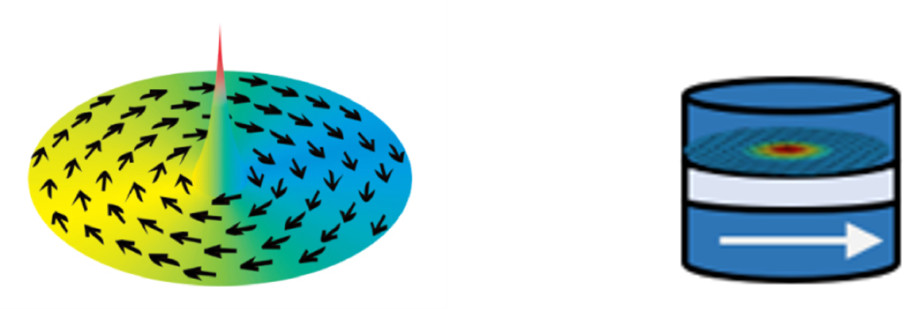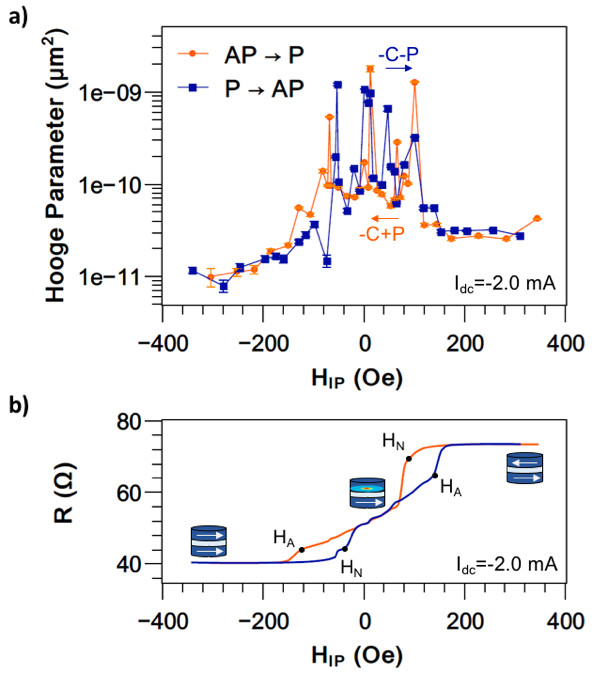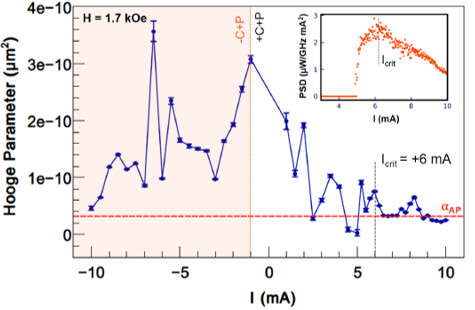Magnetic sensors based on the displacement of a vortex core in a magnetic tunnel junction are currently proposed to obtain linear field responses over a large range (typically a few tens of mT) while keeping a very good sensitivity for various applications (automotive, biomedical). However, these sensors present a very important low frequency magnetic noise which limits their detection performance. In this work, this noise has been characterized and studied as a function of the vortex dynamics and this has allowed to determine solutions to reduce it. The use of AC excitation in these sensors by applying a magnetic field, a DC current or radio frequency (RF), induces a dynamic of the vortex core that prevents it from getting stuck in metastable states, the main source of magnetic noise. “Shaking” the vortex core in this way results in a significant reduction of low frequency noise.
Spin transfer nano-oscillators (STNO) are spintronic devices, composed of a magnetic tunnel junction, and based on the excitation of precession modes with frequencies ranging from less than 100 MHz to tens of GHz [1]. A magnetic tunnel junction is a structure schematically composed of two ferromagnetic layers separated by an insulating thin film through which spin-polarized electrons can tunnel. One of the magnetic layers, the reference layer, has a fixed magnetization while the magnetization of the other layer, the free layer, follows the magnetic field to be detected and induces a variation of the resistance of the structure. STNOs have a particular configuration for which the magnetization of the free layer is distributed in a vortex in its equilibrium state (figure 1).

a b
Figure 1: (a) Vortex-like magnetic structure: the magnetization is chiral in-plane and exits out-of-plane component at the center in the vortex core. (b) Spin transfer nano-oscillators (STNO) in which the free layer is in the vortex state.
The spin-transfer torque-induced precession of the vortex core in STNOs provides a relevant model system to study the dynamics of the corresponding magnetization. Furthermore, they are promising candidates to be integrated into devices used for future high-frequency applications, such as radio frequency generation [2] and detection [3] or bio-inspired computing [4]. The use of vortex-based STNOs in magnetic field sensors with tunneling magnetoresistance (TMR), widely used in the automotive or biomedical fields, is an avenue that has not yet been explored but which would nevertheless present advantages. Indeed, these vortex-based devices offer on the one hand a large linear range for the detection of the magnetic field [5] and on the other hand they have a size of the order of 100 nm which allows to obtain a detection of the magnetic field on a local scale.
One of the main limitations of magnetic sensors, especially those based on vortices, is their intrinsic 1/f noise, which can reduce the detection capability of the device at low frequency. In this work the low-frequency noise of vortex-based STNOs has been studied, comparing the measured noise level in different possible magnetic states. The Hooge parameter [6] – used to characterize and compare the noise properties of the sensors and measured in the uniform states, is of the same order of magnitude as those measured in the state-of-the-art TMR sensors with the same Resistance x Area (RA) product, α = 10-11 – 10-10 µm2. In the vortex state, the measured noise level is about an order of magnitude higher than in the parallel (P) state of the free and reference layer magnetizations (and antiparallel (AP)) (Figure 2), due to the high probability of trapping the center of the vortex on material defects and/or to inhomogeneities in the magnetic properties of the free layer.

Figure 2: Noise represented by the Hooge parameter (a) and resistance (b) of the STNO when a magnetic field is applied to the STNO in the plane. The TMR configuration is a parallel saturated state at negative field and an antiparallel configuration at positive field passing through the vortex state around zero field.
Then the influence of the vortex dynamics in the measured low-frequency noise values was studied (Figure 3 and 4). For a current density above a critical threshold, the spin transfer torques lead to the total compensation of the intrinsic damping of the free layer, resulting in a precessional motion of the vortex core (gyrotropic motion) around its equilibrium position [7]. This self-sustained dynamics prevents the vortex from locking in metastable states and thus strongly reduces the low frequency noise of magnetic origin.

Figure 3: Evolution of the Hooge parameter with the DC current applied in the STNO. The inset shows the amplitude (Power Spectral Density) of the RF emission due to the vortex dynamics. The red dotted line represents the Hooge parameter in the AP state of the STNO.

Figure 4: Hooge parameter as a function of the frequency of an RF current applied in the STNO (a) and when applying an external RF field (b). The red line represents the value of the Hooge parameter in the absence of field and the green dashed line represents the noise in the P state of the STNO. These measurements show the strong reduction of the noise thanks to the use of an RF current or an external RF field to induce self-sustained oscillations of the vortex.
Références
[1] S. Kiselev et al., Nature Vol. 425, 380 (2003)
[2] S. Wittrock et al., Phys. Rev. B Vol. 99, 235135 (2019)
[3] A. S. Jenkins et al., Nat. Nanotech., Vol. 11, 360 (2016)
[4] M. Romera et al., Nature Vol. 563, 230–234 (2018); J. Torrejon et al., Nature, Vol. 547, 428-431 (2017)
[5] D. Suess et al., Nature Electronics volume 1, pages 362–370 (2018)
[6] F. Hooge and A. Hoppenbrouwers, Physica 45, 386-392 (1969)
[7] A. Dussaux et al., Nat. Comm., Vol. 1, 8 (2010)
Work References
Work references:
M. Jotta Garcia, J. Moulin, S. Wittrock, S. Tsunegi, K. Yakushiji, A. Fukushima, H. Kubota, S. Yuasa, U. Ebels, M. Pannetier-Lecoeur, C. Fermon, R. Lebrun, P. Bortolotti, A. Solignac, and V. Cros, “Spin–torque dynamics for noise reduction in vortex-based sensors”, Appl. Phys. Lett. 118, 122401 (2021); https://doi.org/10.1063/5.0040874
Brevet déposé : SYSTEME ET PROCEDE DE SUPPRESSION DU BRUIT MAGNETIQUE BASSE FREQUENCE DE CAPTEURS MAGNETO-RESISTIFS, A. Solignac, M. Jotta Garcia, J. Moulin, S. Wittrock, V. Cros, P. Bortoloti, C. Fermon, M. Pannetier-Lecoeur
Contacts CEA : Aurélie Solignac LNO/SPEC
Collaborations :
- Service de Physique de l’Etat Condensé (SPEC), UMR 3680 CEA-CNRS, Université Paris-Saclay
- Unité Mixte de Physique, CNRS, Thales, Université Paris-Saclay, 91767 Palaiseau, France
- National Institute of Advanced Industrial Science and Technology, Research Center for Emerging Computing Technologies, Tsukuba, Ibaraki 305-8568, Japan
- Univ. Grenoble Alpes, CEA/IRIG, CNRS, GINP, SPINTEC, 38054 Grenoble, France




